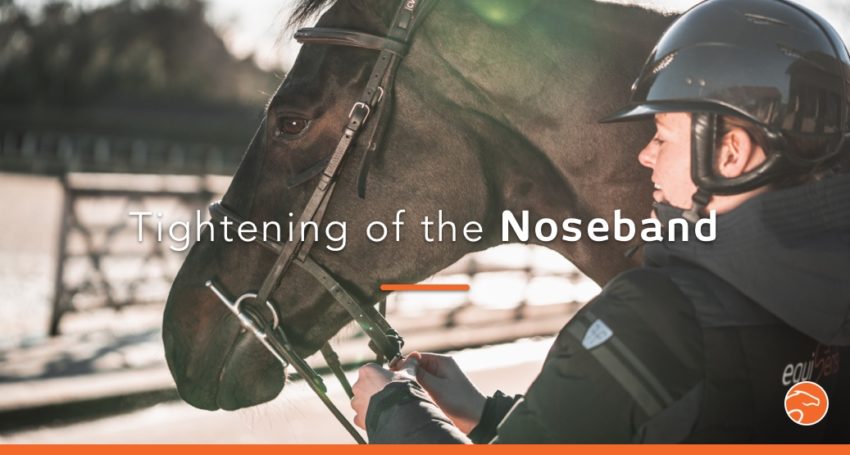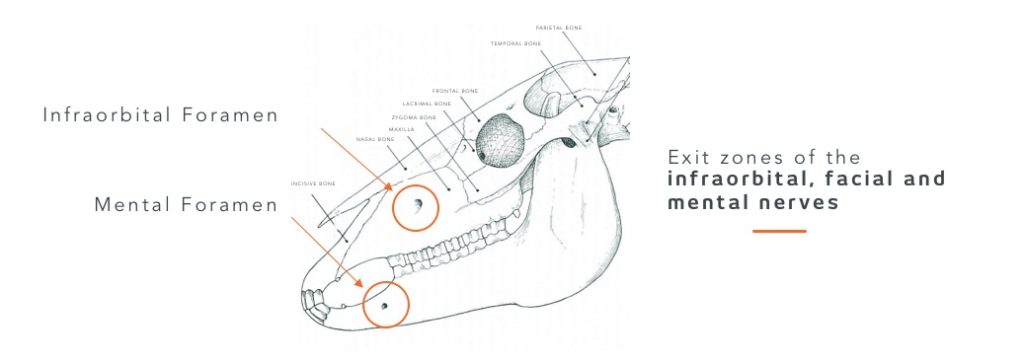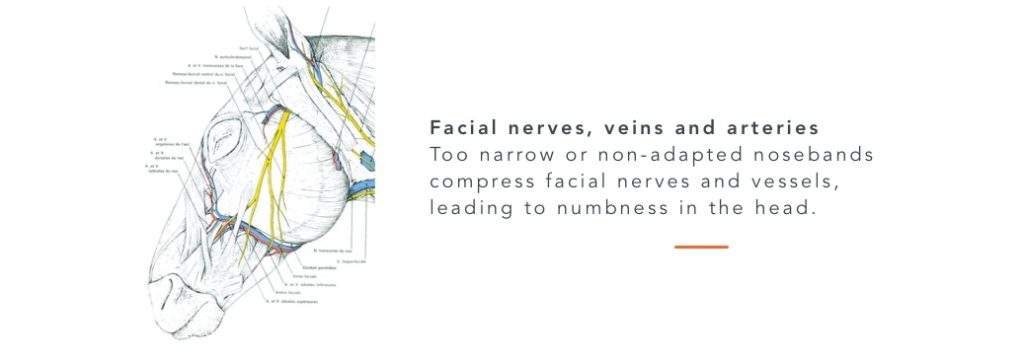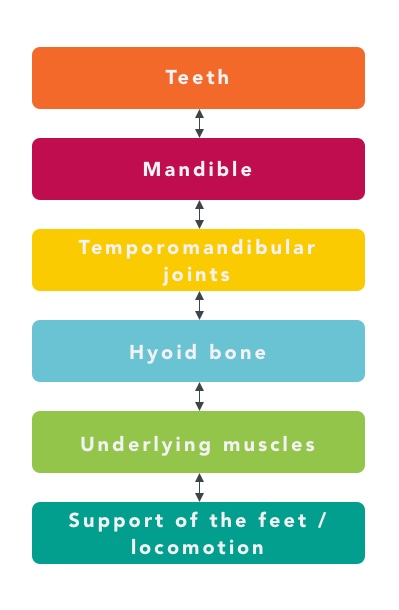
Noseband tightness: How about tightening it less?
This habit of wanting to systematically tighten the noseband of one’s horse is unfortunately well established among riders. The reasons given for this are, among others: “It allows to have more control”, “Without it the horse is less precise in their mouth” or “It is to avoid horses opening their mouth or sticking out their tongue”. The reality is that a too tight noseband is a real pain for the horse. Riders must understand this to overcome their fears and finally succeed in loosening their horse’s noseband a little.
Article based on the work of Patrick Galloux and Dr. Isabelle Burgaud, IFCE (French Institute of the Horse and Horse Riding)
Table des matières
5 examples of harmful consequences caused by a too tight noseband
➡️ A noseband that is too tight generates a lot of stress for the horse.
Numerous studies have been done on the analysis of stress generated by noseband tightening, using several methods. Each time the results are identical: too tight nosebands generate stress for the horse.
Using Heart Rate and Heart Rate Variability
A 2016 study focused on the subject, using heart rate and heart rate variability by comparing 4 levels of noseband tightening. These two parameters were measured at rest, then with the noseband, and finally 10 min after loosening the noseband. The researchers found a very strong increase in heart rate and a very strong decrease in heart rate variability when the noseband is tight. The heart rate remains significantly higher, even 10 minutes after loosening the noseband when it was too tight before, a sign of the intense stress generated by tightening the noseband.
📚 Read too: 5 Reasons to Use a Heart-Rate Monitor With Your Horse
Using Thermography
A 2012 study used the thermography method to measure the stress generated by the noseband fitting.
A correlation had indeed been previously demonstrated between the temperature of the eye (the lacrimal caruncle more precisely) and the level of cortisol, the stress hormone.
In the 2012 study, the researcher shows that the temperature of the eye always rises in the 2 minutes following the tightening of the noseband, whatever the level of tightening, a sign that the very act of putting on the noseband is a source of stress.
In the case of nosebands that are too tight, researchers have observed a significant drop in the temperature of the horse’s cheek. According to them, this is related to the fact that the blood vessels (veins and arteries) of the horse’s face are too compressed by the noseband and therefore the blood no longer circulates properly in the cheek. Hence the drop in temperature.
Experiments carried out in Saumur, France, by Patrick Galloux and Laetitia Boichot are consistent with this study.
Behavioural analysis
From a behavioral point of view, many observations were made.
A study in Saumur was made by analyzing the negative behavioral signs of horses ridden on dressage with different levels of noseband tightening.
Negative behaviors (tail wagging and backwards ears) are clearly diminished when the noseband is loosened, a sign of a better comfort of the horse. This goes without saying, but the decrease of these behaviors is also a sign of better performance in these conditions.
Also, the tightening of the noseband mechanically prevents the horse from opening its mouth and thus chewing. These chewing movements are important for the horse. In ethology, the fact of seeing the horse chewing is a strong sign of relaxation and acceptance of the work in progress. Preventing this natural behavior is therefore a source of stress for the horse.
Similarly, a 2016 study shows that once the noseband is loosened, the horse immediately starts chewing, swallowing and licking again. This inability to express natural behavior is considered a real source of stress for the horse.
📚 Read too: 10 Horsemanship Ethology Principles All Riders Should Know
➡️ A noseband that is too tight can deform the bones of the horse’s head.
Yes yes, you read well. A noseband that is too tight ends up deforming the skull bones. And that’s not rare at all. In fact, you have certainly already crossed horses with a marked deformation of the noseband. But you can imagine that, even if it is done in the long term, you don’t deform a bone without pain.
Lesions can also be on the skin and hair.
➡️ A noseband that is too tight compresses the nerves, veins and arteries of the face.
In addition to preventing the horse from breathing properly because of the pressure on the nose, nosebands that are too tight will compress the nerves and blood vessels of the face.
Indeed, the cranial nerves of the horse come out of the horse’s skull through 2 “holes” called “foramen”: the infraorbital foramen and the mental foramen. The nerves of the face (facial, infraorbital and mandibular) are then directly under the skin. The problem is that nosebands, even anatomical nosebands, cut the paths of these nerves.
It is the same for the facial artery and vein.

Thus, nosebands that are too tight compress nerves, arteries and veins against the bone.
This leads to numbness, as well as a potential decrease in the motor skills of the face.

➡️ A noseband that is too tight can create very painful mouth injuries.
In Humans, the dental table (the top of the teeth, very roughly), is approximately horizontal. In the horse, it is not the case. Their dental table is oblique, following a line that goes from the inside – up, to the outside – down. Thus the premolars and molars at the top are longer on the outside.
Also, as the horses’ teeth grow continuously, the upper teeth push outward and downward. Thus, in horses whose mouth is not perfectly maintained, a noseband that is too tight will pinch the skin from the inside of the cheek against the tooth, forming injuries called “cheek ulcers“.
In addition, the presence of extra teeth in front of the premolars can lead to injuries at the corner of the lips due to overtightening of the noseband. Indeed, the noseband will tighten the corner of the lips between the bit and the wolf tooth, causing a very painful injury.
➡️ A noseband that is too tight has a significant impact on the horse’s locomotion.
All approaches (the approach of the veterinarian, the osteopath and the acupuncturist) lead to a link between the mouth and locomotion, in particular thanks to a bone structure called the hyoid bone.
As a result, mouth problems and postural problems and therefore locomotor problems are very closely related. It is a very well known and documented phenomenon in humans, so that chiropodists regularly refer their patients to the dentist to solve their postural problems in depth.
Thus, the fact that the horse’s mandible is restricted in its movements because of the noseband, and this in the 3 directions of space, leads to a dysfunction of the mouth, the upper cervicals and the hyoid, thus of the forelegs. It is then clear that the locomotion is impacted. A drop in performance therefore undoubtedly ensues.

What is the use of the noseband in then?
The question does indeed arise. In fact, more and more riders are choosing to remove the noseband completely, as many great riders used to do in the past. However, the absence of a noseband does not seem to solve all the problems since a study made on more than 3000 horses showed that horses ridden without a noseband had more injuries in the mouth than horses ridden with a loose noseband.
Apart from the aesthetic aspect of the noseband, the noseband can be useful to limit the excessive opening of the horse’s mouth, while allowing sufficient opening for the horse to chew and swallow. This can be particularly the case when the safety of the couple is a priority, as on the cross-country for example.
The noseband and its excessive tightening must in no way be a solution to a behavioral problem on the part of the horse.
“The noseband must in no case be a muzzle.”
Patrick Galloux, horseman of the Cadre Noir of Saumur
How do you know if your horse’s noseband is too tight?
It is often said that the optimal setting is 2 fingers between the noseridge and noseband. The problem is that the size of the fingers varies a lot from one individual to another.
Scientists therefore looked at the circumference of the noseridge with the mouth closed and when the horse chews. The difference in circumference between the two is 3 cm. It is therefore advisable to be able to pass at least 2 fingers between the noseridge and the noseband.
Be careful,, the measurement should always be taken above the noseridge and not below the mandible.
The ISES (International Society for Equitation Science) has also marketed a gauge to ensure that the noseband is not too tight. If you are able to slide the gauge to the line without forcing, the noseband is well adjusted.
Some observations may indicate that the noseband is too tight. This is especially the case for those horses that drool excessively, especially those that drool without making foam. Indeed, when the noseband is too tight, horses can no longer swallow their saliva. They then start drooling without being able to hold it back.
As a reminder, a good level of salivation can be seen in the “lipstick” effect. The slightly foaming saliva just gets to the edge of the horse’s lips, no more. Beyond that, it can be considered as excessive salivation, sign of a too tight noseband or an unsuitable bit.
How to better manage undesirable behaviors without tightening your horse’s noseband?
At this stage, you may begin to be convinced that you need to tighten your horse’s noseband less. However, it is possible that you may fear certain undesirable behaviors from your horse with these new settings.
Here are a few tips to help you manage this serenely.
Try it, you’ll see!
First of all, you don’t risk much to try, on a few sessions (on the flat at first), to loosen the noseband frankly. This little experiment will help you to identify changes in your horse’s behaviour. You will see that, perhaps, they will be more relaxed, that they will chew a little more.
Dentist, bitfitter and osteopath, the striking trio
If you ever find that your horse’s mouth is opening too much, sticking out their tongue or is too hard, then we strongly advise you to call in an equine dentist to make sure that your horse’s mouth is in good condition, as well as a bitfitter.
These people are specialized in adapting the bridle and bit to the morphology of your horse. You will be surprised at the radical and extremely rapid changes that a change of bridle and bit can cause.
(And don’t think you can improvise being a bitfitter with the few bits you have at home. When you see the amount of material they have and the fine-tuning they do, you’ll understand why it’s a profession in its own right. 😉)
📚 On the same topic: 5 Minutes to Understand How to Find the Right Bit for Your Horse
In addition to the visit of the dentist and the bitfitter, a visit from an osteopath can be a real plus. As you have seen above, the physical consequences of tightening the noseband are important. The osteopath can help to put your horse back on its feet. Also, certain undesirable behaviors masked by a too tight noseband (and which can therefore come back by loosening the noseband) can be linked to musculoskeletal disorders that the osteopath can help to solve.
Finally, a horse in good health and physical condition, with equipment adapted to their morphology, which nevertheless continues to show undesirable behaviors at work, must lead to a questioning of the correctness and finesse of the rider’s actions. (It is longer and more difficult but it costs less…)
Conclusion
Whatever the approach or method used (behaviorists, veterinarians, dentists, or even the great founding riders of horse riding, osteopaths and acupuncturists, not developed here), all agree on this point: tight nosebands are harmful to the horse. The scientific proofs, validated, are there. The reasons that pushed the riders to tighten their nosebands can all be solved otherwise than by using this painful and stressful method for the horse.
It is therefore high time that we, riders, took hold of this, and that we overcome our fears and difficulties that we thought would be solved by tightening the noseband.
So try it. From your next session, loosen your noseband, leave 3 cm free between the noseridge and the noseband, and observe the results. You will probably be surprised.
See you soon for a new article,
Camille Saute
Co-founder of Equisense and R&D manager
Bibliographie
Galloux, P., & Burgaud, I. (2020). La muserolle : choix, emploi et serrage. Equipedia.
Galloux, P., & Burgaud, I. (2020). La muserolle : la serrer, une habitude contre nature. Equipedia.